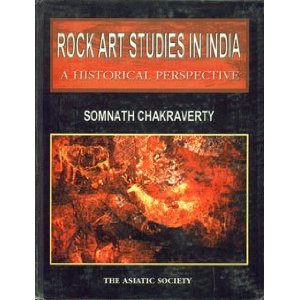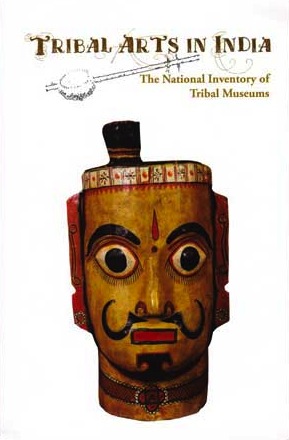
Rock art studies in India is not only restricted to the Palaeolithic period, it extends even beyond it. In the Indian subcontinent the caves and rock shelters were inhabited and used by people over many periods, throughout which the rock walls were used as a convenient canvas to visually express and transmit their idea, ethos, aspirations and messages. In India, the rock art sites of prehistoric and early preliterate societies sometimes coexist with the extensively painted caves that were cut into the rock by Buddhist monks during the historic past. – p. 1
Akin to the lithic toolmaking industries of prehistoric groups, through the passage of time, rock art also underwent gradual refinement with the accumulation of evolved skill with experiences and changes in its implications. Refinement of rock art therefore is an integral part of its historical and evolutionary process. In India, evolution of rock art has taken two different courses. While one stream continues through tribal and folk forms, the other closely adhered to the classical idiom has been patronized by the royalty, nobility, at times even by the monastic organizations. It is found how elements of the prehistoric rock art have survived in certain motifs and objects as tribal and folk art idioms. But the changes in imaginative conception, in style and form also took place because of the patronage given by contemporary royal “courts” or monasteries. The evidence of inscriptions and rock edicts of later periods discovered in some primordial rock art sites suggest the occupation and use of the same locale in successive cultural periods. It is possible to perceive the growth and development of such multifunctional aspects of rock art in India through different chrono-cultural stages. – p. 2
Ancient megalithic monuments are not rare in Assam and its neighbouring states of the north-east (Mills and Hutton, 1929). As a matter of fact, megalith-building is a living tradition in the region being practiced by the matriarchal groups and some other discrete tribal communities till date. The central Indian plateau shows a major concentration of naturalistic paintings including compositions narrating episodes. – pp. 3-4
To obtain a more meaningful result, rock art must be viewed, compared and integrated with other archaeological evidence in a distinctive cultural matrix of a region. The uniqueness of primeval rock art in India is that a continuum of the art tradition is evident among pre-literate and indigenous ethnic entities. Therefore close comparisons between the rock art and material culture, social organization, religious belief and practices among the indigenous egalitarian societies [adivasi] may render suitable clues for explaining the ethnic identity of art practicing groups in the past. – p. 51
Source: Chakraverty, Somnath. Rock Art Studies in India: A Historical Perspective. Kolkata: The Asiatic Society, 2003.
isbn 8172361378
Price: Rs. 400 / $ 40
[References to the Edkal (Edakkal) cave in Wynaad (Wayanad) District pp. 11-13]
[Bold typeface added above for emphasis]
Find publications by reputed authors (add “open access” for freely downloadable content)
PDF-repository: texts quoted & further reference (Google Drive) >>
Edakkal Cave
[…] The Edakkal cave in the Ambukuthy Mountain is not a cave in the real sense. As stated in the India Antiquary (Vol.XXX, page – 410) and quoted in the District Gazetteer, Kozhikode, it is only ‘a cleft about 96 ft. long and 22 ft. wide in the rock’. It is a fissure made by a corner of rock splitting off from the main body due to some natural causes. […] The rock wall contains some interesting carvings, which represent human and animal figures and objects of human use and symbols. These carvings speak of a highly civilized people of pre-historic are and inspires the archaeologists and historians to rewrite the history of Wayanad and Kerala as a whole.
Source: official web site of wayanad
Address : http://www.wyd.kerala.gov.in/places.htm
Date Visited: Wed Jul 20 2011 15:40:22 GMT+0200 (CEST)
Up-to-date reports by Indian journalists and commentators
To search Indian periodicals, magazines, web portals and other sources safely, click here. To find an Indian PhD thesis on a particular tribal community, region and related issues, click here >>
Search tips
Combine the name of any particular state, language or region with that of any tribal (Adivasi) community.
Add keywords of special interest (music, poetry, dance just as health, sacred grove and biodiversity); learn about the rights of Scheduled Tribes such as the “Forest Rights Act” (FRA); and the United Nations “Declaration on the Rights of Indigenous Peoples”, “Universal Declaration of Human Rights”, “women’s rights”, or “children’s right to education”.
Specify any other issue or news item you want to learn more about (biodiversity, bonded labour and human trafficking, climate change, ecology, economic development, ethnobotany, ethnomedicine, global warming, hunter-gatherers in a particular region or state, prevention of rural poverty, water access).
For official figures include “scheduled tribe ST” along with a union state or region: e.g. “Chhattisgarh ST community”, “Himalayan tribe”, “Scheduled tribe Tamil Nadu census”, “ST Kerala census”, “Particularly Vulnerable Tribal Group Jharkhand”, “PVTG Rajasthan”, “Adivasi ST Kerala”, “Adibasi ST West Bengal” etc.
In case the Google Custom Search window is not displayed here try the following: (1) toggle between “Reader” and regular viewing; (2) in your browser’s Security settings select “Enable JavaScript” | More tips >>
Note: hyperlinks and quotes are meant for fact-checking and information purposes only | Disclaimer >>

Tribal Arts in India | Worldcat.org >>
Free eBooks & Magazine by Bhasha Research and Publication Centre: Adivasi literature and languages >>
Learn more
Crafts and visual arts | Fashion and design | Masks
eBooks, eJournals & reports | eLearning
eBook | Background guide for education
Forest dwellers in early India – myths and ecology in historical perspective
Himalayan region: Biodiversity & Water
History | Hunter-gatherers | Indus Valley | Megalithic culture | Rock art
Languages and linguistic heritage
Modernity | Revival of traditions
Tribal Research and Training Institutes with Ethnographic museums